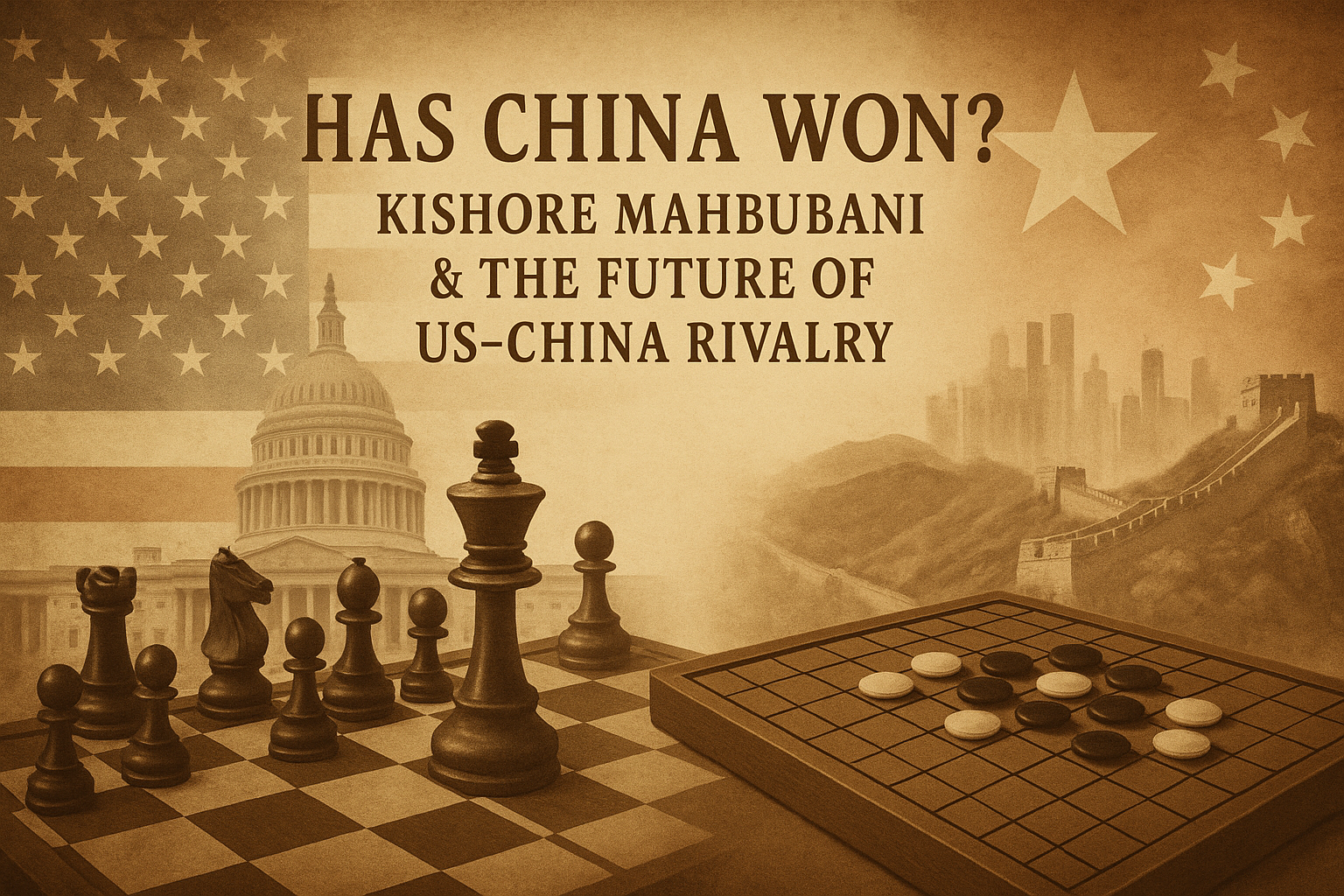Your cart is currently empty!

Has China Won? Kishore Mahbubani on America’s Strategic Dilemma in the 21st Century
Thinking the Unthinkable: Can America Lose?
The introduction to Kishore Mahbubani’s book begins with a challenge that cuts through American exceptionalism: the possibility that America, long crowned as the most powerful nation, could lose its supremacy. For decades, Americans assumed that their military, economy, and democracy formed an unbeatable combination. Yet Mahbubani reminds us that history is filled with fallen empires that believed they were invincible—Rome, Britain, and the Soviet Union. The idea of American decline is not unthinkable; it is entirely plausible.
America has defined its identity as a nation that always prevails. Victory in the two World Wars, triumph in the Cold War, and unmatched global dominance in the post-1990s era reinforced this belief. But the emergence of China introduces a rival unlike any America has ever faced. Unlike the Soviet Union, China is not a closed economy collapsing under its own inefficiencies. It is instead an adaptive, disciplined, and highly connected civilization-state.
This forces America into a difficult reflection. If victory is no longer guaranteed, what then anchors its foreign policy? If the belief in inevitable dominance collapses, what strategies remain available? To continue on autopilot—assuming strength without recalibrating—would be to repeat the mistakes of past declining powers.
At stake here is not simply geopolitics, but the American psyche. The loss of primacy would mean rethinking the very idea of America’s role in the world. For a nation that has long styled itself as “the indispensable nation,” accepting parity or even inferiority is a cultural as well as a strategic trauma.
Mahbubani’s provocation is useful. It forces policymakers, scholars, and even citizens to confront scenarios they would rather ignore. A true strategist, as Singapore’s leaders have always understood, must “think the unthinkable.” To do otherwise is to be blindsided.
Thus, the book’s first lesson is about America’s blind spots, not China. Only when America asks itself whether it can lose can it truly begin to reason about how to avoid that fate.
Misreading China: Communist or Civilizational?
A central thesis of Mahbubani’s work is that America risks misdiagnosing China. Washington insists on framing the Chinese Communist Party (CCP) purely as a communist entity, locked in Marxist-Leninist ideology. This frame mirrors Cold War logic, which worked against the Soviet Union. But China is not the Soviet Union, and the CCP is not merely a Leninist party.
To many Asian observers, the CCP functions more like a “Chinese Civilization Party.” Its power lies not in ideology imported from Europe, but in continuity with China’s 5,000 years of history. Its legitimacy is drawn less from Karl Marx than from the Mandate of Heaven. By misunderstanding this, America risks fighting the wrong war with the wrong tools.
The Soviet Union sought to export ideology globally; China does not. Instead, China aims to restore its historical place at the center of Asia and eventually the world. Its policies are pragmatic, driven by performance legitimacy: growth, stability, and national pride. The CCP is tolerated—and even embraced—by the Chinese people because it delivers.
If American strategists continue to refer to China simply as “communist,” they miss the deeper civilizational drive shaping Beijing’s moves. This misreading creates dangerous distortions. Washington may expect China to collapse under ideological contradiction, as the USSR did. But China is not ideologically brittle. It is civilizationally resilient.
This insight demands a new lens: one that views China as a civilization-state, not merely a nation-state. Its ambitions are different, its logic is different, and its time horizon is different. To fight a civilization with the tools of ideological containment is to misplay the game from the start.
In the end, America’s most significant mistake may not be China’s rise, but its own blindness in perceiving what China truly is.
The Wei Qi Mindset
Henry Kissinger often observed that America plays chess, while China plays go (also known as wei qi). In chess, the goal is to capture the king quickly, often through bold and decisive moves. In Wei Qi, the goal is patience: slowly encircling, accumulating small advantages, and positioning for eventual dominance. Mahbubani employs this metaphor to illustrate the strategic cultural clash between Washington and Beijing.
American foreign policy thrives on quick results. Elections push leaders toward short-term gains, military interventions, and sanctions that signal strength in the moment. China, by contrast, thinks in centuries. Its Belt and Road Initiative (BRI), its investments in Africa and Southeast Asia, its AI-driven industrial policy—all are long games. None offers immediate victory, but collectively they reshape global structures.
This divergence creates asymmetry. America demands quick wins but burns out resources; China absorbs setbacks but continues to advance. Over decades, the patient player accumulates an advantage. The chess player may checkmate a king, but the wei qi player surrounds the entire board.
In Southeast Asia, its influence is acutely felt. The United States sails warships through the South China Sea to demonstrate its power, but China builds artificial islands and quietly expands its presence. America criticizes, sanctions, and withdraws from treaties; China finances, invests, and expands ties. The wei qi stones are placed patiently, one by one, until the map itself undergoes a change.
For America, adapting to wei qi requires a cultural shift. It must learn to value endurance over flash and positioning over posturing. This may be its most complex challenge, for it goes against the very rhythm of American politics.
The actual question then emerges: can a democracy that thinks in two-year cycles survive against a civilization that feels in two-hundred-year arcs?
America’s Soft Power in Decline
Another critical theme in the introduction is the erosion of America’s soft power. During the Cold War, America was admired not just for its strength but for its vitality. Its music, movies, universities, and openness attracted the world. Joseph Nye’s term “soft power” captured this magnetism: the ability to lead by attraction rather than coercion.
From the 1960s to the 1980s, America radiated confidence. The world wanted to study in its schools, consume its culture, and emulate its democracy. Even in the midst of Vietnam and Watergate, America had a certain allure. Its ideals of freedom and innovation were aspirational.
But after 9/11, much changed. The wars in Iraq and Afghanistan tarnished its image. The return to unilateralism under Trump further alienated the United States’ allies. Even the weaponization of the US dollar—a powerful tool of sanctions—shifted from multilateral legitimacy to unilateral coercion. Instead of inspiring, America is increasingly compelled.
Meanwhile, China invested in global partnerships. Its universities climbed rankings, its technology firms grew formidable, and its cities showcased modernity. For many in the developing world, China now represents a symbol of progress. America still holds prestige, but its aura has dimmed.
Soft power matters because global leadership is not only about fear but also about admiration. If America loses its cultural and moral authority, it may still win battles but lose the war for legitimacy. And in a long contest with China, legitimacy is a decisive factor.
Thus, America’s challenge is not just to rebuild its military power but to restore the charm that once made it irresistible. Without it, even allies may quietly drift toward Beijing.
The Big Ten Strategic Questions
Mahbubani structures his introduction around ten questions that America must answer to respond effectively to China’s rise. These are not mere policy issues, but existential dilemmas that profoundly impact American strategy.
The first concerns economics: could America’s GDP be overtaken by China’s within thirty years? If so, how must America adapt when it no longer commands global economic primacy? This is a tectonic shift—one the world has not seen since the 19th century, when Britain ruled the global economy.
The second question is whether America should prioritize the well-being of its 330 million citizens or the preservation of its primacy. What if these goals diverge? Should America spend on health, education, and infrastructure—or on aircraft carriers and faraway wars?
Third, Mahbubani asks whether America risks repeating the Soviet mistake: overspending on defense while neglecting the economy. China, by contrast, spends less on defense proportionally and more on development. Has America trapped itself on an unsustainable path?
Fourth, he highlights alliances. America won the Cold War not alone, but with NATO and a coalition of allies. Yet Trump’s America First approach alienated partners. Can America counterbalance China without strong alliances? Or has it ceded ground to China’s Belt and Road diplomacy?
The remaining questions address deeper strategic culture: Does America understand the Chinese psyche? Can it adapt its frameworks? Does it risk letting emotions—such as fear, pride, and anger—cloud its strategy? Lastly, does it possess the endurance to engage in a long-term strategy?
By posing these questions, Mahbubani does not predict China’s inevitable victory. Instead, he demonstrates that America could become its own greatest adversary if it fails to face harsh realities.
Conclusion: Between Chess and Wei Qi
Mahbubani’s Has China Won? is not a triumphalist narrative for Beijing. It is, instead, a mirror held up to America, forcing it to see its vulnerabilities. The contest is not yet decided, but the patterns are visible: impatience versus patience, ideology versus civilization, and soft power decline versus quiet ascent.
The true victory will not come through one decisive clash, but through the long, grinding accumulation of moves—economic, cultural, and technological. In that game, America must ask whether it is still capable of the discipline, humility, and endurance that global leadership requires.
For Southeast Asia, where both giants cast their shadows, the answer matters profoundly. The region does not want to choose between the two, but it will inevitably feel the weight of their contest. In this sense, Mahbubani speaks not only to Washington and Beijing but to all who live between them.
The question, “Has China won?” remains open. However, the real danger, as this introduction reveals, is not that China is unbeatable, but that America might defeat itself.


Leave a Reply